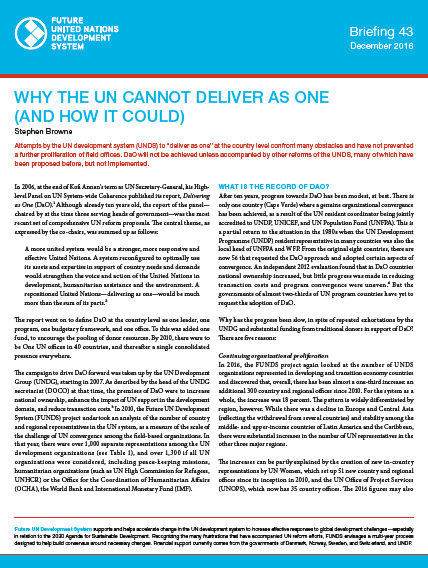Attempts by the UN development system (UNDS) to “deliver as one” at the country level confront many obstacles and have not prevented a further proliferation of field offices. DaO will not be achieved unless accompanied by other reforms of the UNDS, many of which have been proposed before, but not implemented.
In 2006, at the end of Kofi Annan’s term as UN Secretary-General, his High-level Panel on UN System-wide Coherence published its report, Delivering as One (DaO). Although already ten years old, the report of the panel— chaired by at the time three serving heads of government—is the most recent set of comprehensive UN reform proposals. The central theme was summed up as:
“A more united system would be a stronger, more responsive and effective United Nations. A system reconfigured to optimally use its assets and expertise in support of country needs and demands would strengthen the voice and action of the United Nations in development, humanitarian assistance and the environment. A repositioned UN—delivering as one—would be much more than the sum of its parts.”
The report went on to define DaO at the country level as one leader, one program, one budgetary framework, and one office. To this was added one fund, to encourage the pooling of donor resources. By 2010, there were to be One UN offices in 40 countries, and thereafter a single consolidated presence everywhere.
The campaign to drive DaO forward was taken up by the UN Development Group (UNDG), starting in 2007. The premises of DaO were to increase national ownership, enhance the impact of UN support in the development domain, and reduce transaction costs.
In 2010, the Future UN Development System (FUNDS) project undertook an analysis of the number of country and regional representatives in the UN system, as a measure of the scale of the challenge. In that year, there were over 1,000 separate representations among the UN development organizations, and over 1,300 if all UN organizations were considered, including peace-keeping missions and humanitarian organizations.
What is the record of Delivering as One?
After ten years, progress towards DaO has been modest, at best. There is only one country (Cape Verde) where a genuine organizational convergence has been achieved, though there are now 56 countries that have requested the DaO approach and adopted certain aspects of convergence. An independent 2012 evaluation found that in DaO countries national ownership increased, but little progress was made in reducing transaction costs and program convergence were uneven. But the governments of almost two-thirds of UN program countries have yet to request the adoption of DaO.
In 2016, the FUNDS project again looked at the number of UNDS organizations represented in developing and transition economy countries and discovered that, overall, there has been almost a one-third increase: an additional 300 country and regional offices since 2010. For the UN system as a whole, the increase was 18 percent.
Why has the progress been slow, in spite of repeated exhortations by the UNDG and substantial funding from traditional donors in support of DaO? This briefing paper presents five reasons:
1. Continuing organizational proliferation
2. Lack of government interest
3. Differing organizational procedures and practices
4. Competition for funds
5. No head of UN development
What can be done?
DaO still represents a worthy goal. Before deciding what needs to be done to achieve it, however, it is necessary to define—more clearly and realistically in the light of experience—what it should mean in practice. DaO should lead to a convergence of UN ideas, policies, and programs, but not of structures. Organizations should be able to retain their individual identity, but there should be much closer harmonization—and where possible integration—of in-country administrative services. It is also clear that donors will not give up their proclivities for earmarking, but there are still ways of achieving greater coherence even with distributed patronage.
Starting with the fifth challenge, António Guterres should appoint a development coordinator as deputy secretary-general, with the status and authority to take strategic decisions on behalf of the UNDS, and become the overseer of the network of resident coordinators, which is currently—and ambiguously—administered by UNDP.
Next, there should be a brake on the creation of new representative offices, particularly by the funds and programmes that fall under the authority of the UN secretary-general and the new development coordinator, who should require the financial justification for any expansion of UN offices.
Earmarking has made it difficult for individual organizations to turn down offers of new funds, even at the cost of straying beyond their mandates. As a counterweight to competition and mission-creep, the UN should more aggressively pursue pooled funding, and parallel funding by individual donors should be discouraged.
DaO also requires cultural changes within the UNDS, which will need to be stimulated and rewarded. Because resource mobilization is a prime criterion for career success, program staff are motivated to establish themselves as their own project managers, raising and spending money raised from donors. The result is a UNDS characterized by hundreds of thousands of individual projects, many of which operate independently, even within each organization. Incentive systems should be redirected at rewarding staff for strengthening partnerships with other UNDS organizations.
If any of this appears utopian, given the past record of UN change, it is important to stress that these reforms would be within the power of a UN secretary-general committed to fulfilling the objectives of a program that member states agreed over a decade ago.
Download 'Why the UN Cannot Deliver As One (and how it could)' in pdf 